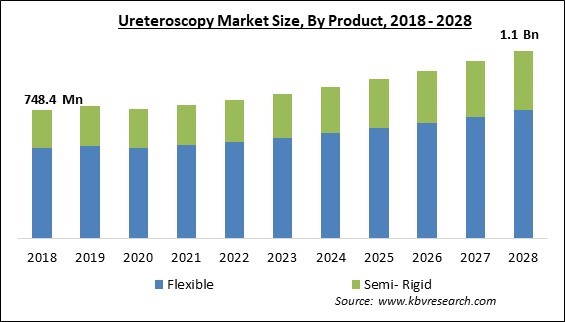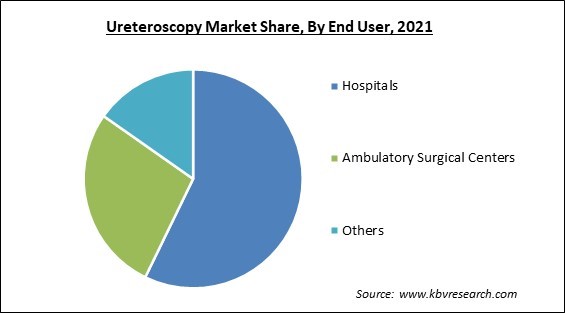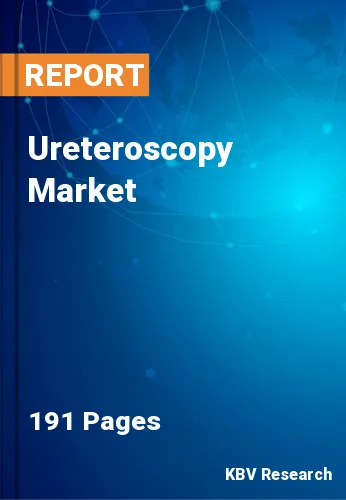The Global Ureteroscopy Market size is expected to reach $1.1 billion by 2028, rising at a market growth of 5.2% CAGR during the forecast period.
A specific type of endoscope called a ureteroscope is rigid, flexible, or semi-flexible, with a camera and light source at one end. Endoscopes, known as ureteroscopes are used to see within the urinary tract and examine it. Particularly long and narrow, ureteroscopy can be placed into the urethra, into the bladder, and into the ureter. These endoscopes are used for visual inspections and tool-assisted ureter internal examinations.

Urinary strictures, kidney cancer, kidney stones, and upper urinary tract urothelial carcinoma can all be detected and treated using this method. Several varieties of ureteroscopic are available, including flexible, stiff, semi-rigid, single-use, and double-channel ureteroscopes. A small telescope called a ureteroscope is sent through the bladder and urethra and up the ureter to the spot where the stone is placed during ureteroscopy, a treatment used to treat kidney stones.
The surgery typically takes one to three hours and is usually done while the patient is under general anesthesia. Smaller stones can usually be removed whole from the ureter by being captured in a basket device. If the stone is huge or the ureter's diameter is small, it must then be broken apart, usually with a laser. The stone is divided into tiny bits before these fragments are removed. The ureter may enlarge as a result of the ureteroscope's passage. To ensure that the kidney drains urine effectively, it may be essential to temporarily leave a small tube known as a ureteral stent inside the ureter.
The COVID-19 pandemic caused supply chains in a number of end-user industries, including industrial, healthcare, and medical devices. Moreover, a decline in urology hospital visits and fewer urology hospitals throughout the pandemic may limit the use of ureteroscope devices and restrain market expansion. Also, the lockdown's impact on urological surgeries caused a reduction in the demand for ureteroscopes, which also restrained market expansion. Because of the COVID-19 pandemic, people have put off elective surgeries. Due to the serious risk of viral transmission, people have also put delayed treating kidney stones for a long. In addition, emerging countries are expected to experience extremely robust sales of advanced ureteroscope technology.
According to World Health Organization; one in six people globally will be 60 or older by 2030. By this point, there will be 1.4 billion people over 60, up from 1 billion in 2020. The proportion of people above 600 will double itself by 2050. Between 2020 and 2050, the number of people 80 or older is projected to treble, reaching 426 million. Although population aging, or the movement in a country's population's distribution towards older ages, began in high-income nations, it is currently low- and middle-income nations that are going through the most significant transformation. This will drive up demand for ureteroscopy during the anticipated period.
Minimally invasive surgeries are considerably less dreadful than conventional open surgeries. Traditional operations performed with traditional laparoscopic tools can be challenging and upsetting. Specialized, compact equipment is used throughout the process, and minimally invasive surgical cameras are inserted through smaller incisions. Patients who undergo minimally invasive procedures recover more rapidly and with less discomfort. Minimally invasive surgical procedures are gaining popularity because they need fewer hospital stays, are more precise, leave fewer scars, are less painful, and require smaller incisions.

Stent pain is the most prevalent risk or complaint after ureteroscopy, occurring in many patients who had a stent placed during a ureteroscopy. A stent is a flexible plastic tube that permits the kidney to drain to the bladder despite edema or occlusion. It is around half the size of IV tubings. In addition to allowing urine to pass up from the bladder to the kidney during urination, the stent can "rub" on the inside of the bladder, giving the sensation of needing to urinate or having an overactive bladder. This can result in symptoms ranging from a warm, tingling sensation to severe pain in the affected flank.
Based on product, the ureteroscopy market is segmented into flexible and semi- rigid. In 2021, the semi-rigid segment covered a considerable revenue share in the urethroscopy market. A semi-rigid ureteroscope is an instrument used to view the interior of the urinary tract. A ureteroscope is used to see into the ureters, the tubes that convey urine from the kidneys to the bladder, which are longer and thinner than the cystoscope. Moreover, a stone in the ureter can be seen, fragmented, and removed by the doctor using a semi-rigid ureteroscope. Thus, using semi-rigid to look within the urinary tract, along with other advantages, is anticipated to drive the segment's expansion.
On the basis of application, the ureteroscopy market is divided into urolithiasis, kidney cancer, urinary stricture and others. In 2021, the urolithiasis segment witnessed the largest revenue share in the ureteroscopy market. This is due to the elevated prevalence of chronic kidney disorders and kidney stone development, particularly in adults, raising the demand for ureteroscopes. "Urolithiasis" refers to calculi or stones that develop in the urinary tract. The urinary system, primarily the kidneys or ureters but often the bladder and/or urethra, develop calcifications due to this illness. These elements will boost ureteroscopy utilization and fuel the segment's growth.
By end user, the ureteroscopy market is classified into hospitals, ambulatory surgical centers, and others. The hospital segment dominated the ureteroscopy market with the maximum revenue share in 2021. The adoption of technologically improved ureteroscope devices, a well-equipped infrastructure, increased purchasing power, and an increase in patient admission all contribute to this. Also, a rise in patients' preference for hospitals, which properly administer treatments under the supervision of knowledgeable doctors, is another factor driving the segment's expansion.
| Report Attribute | Details |
|---|---|
| Market size value in 2021 | USD 779.2 Million |
| Market size forecast in 2028 | USD 1.1 Billion |
| Base Year | 2021 |
| Historical Period | 2018 to 2020 |
| Forecast Period | 2022 to 2028 |
| Revenue Growth Rate | CAGR of 5.2% from 2022 to 2028 |
| Number of Pages | 191 |
| Number of Table | 350 |
| Report coverage | Market Trends, Revenue Estimation and Forecast, Segmentation Analysis, Regional and Country Breakdown, Companies Strategic Developments, Company Profiling |
| Segments covered | Product, Application, End User, Region |
| Country scope | US, Canada, Mexico, Germany, UK, France, Russia, Spain, Italy, China, Japan, India, South Korea, Singapore, Malaysia, Brazil, Argentina, UAE, Saudi Arabia, South Africa, Nigeria |
| Growth Drivers |
|
| Restraints |
|
Region-wise, the ureteroscopy market is analyzed across North America, Europe, Asia Pacific, and LAMEA. In 2021, the North America region generated the maximum revenue share in the ureteroscopy market. The availability of cutting-edge ureteroscopes increased frequency of kidney problems, and increased awareness of renal diseases are projected to propel the market in the region. The market is also growing due to other factors like advantageous reimbursement policies, patient consciousness, and the use of cutting-edge instruments. The industry is also driven by increased pediatric stone cases in the area.
Free Valuable Insights: Global Ureteroscopy Market size to reach USD 1.1 Billion by 2028
The market research report covers the analysis of key stake holders of the market. Key companies profiled in the report include Boston Scientific Corporation, Olympus Corporation, Hoya Corporation, Steris PLC, Stryker Corporation, Advin Health Care, Karl Storz SE & Co. KG, Richard Wolf GmbH, Cliniva Healthcare, and OTU Medical Inc.
By End User
By Product
By Application
By Geography
The global Ureteroscopy Market size is expected to reach $1.1 billion by 2028.
Rising old aged population across the globe are driving the market in coming years, however, Possible side effects of ureteroscopes restraints the growth of the market.
Boston Scientific Corporation, Olympus Corporation, Hoya Corporation, Steris PLC, Stryker Corporation, Advin Health Care, Karl Storz SE & Co. KG, Richard Wolf GmbH, Cliniva Healthcare, and OTU Medical Inc.
The expected CAGR of the Ureteroscopy Market is 5.2% from 2022 to 2028.
The Flexible segment acquired maximum revenue share in the Global Ureteroscopy Market by Product in 2021 thereby, achieving a market value of $752.5 Million by 2028.
The North America market dominated the Global Ureteroscopy Market by Region in 2021, and would continue to be a dominant market till 2028; thereby, achieving a market value of $415 Million by 2028.
Our team of dedicated experts can provide you with attractive expansion opportunities for your business.

